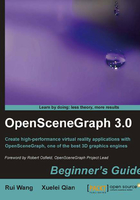
A quick overview of rendering middleware
Before entering the world of OpenSceneGraph, we assume that you are already experienced in OpenGL programming. You work with stacks of matrices, set pipeline states, look for new extensions, call rendering APIs or commands and immediately draw them on a context, no matter if you are enjoying or suffering from the whole process.
A rendering middleware is a solution that raises the level of abstraction and eases the complexity of using a low-level OpenGL API, at the cost of flexibility. The concepts of modularity and object-orientation are often applied to manage graphics primitives, materials, and different visual data sets in user applications, saving much development time and allowing new functionalities to be combined as modules and plugins.
OpenSceneGraph is a well-designed rendering middleware application. It is actually a retained rendering (or deferred rendering) system based on the theory of scene graph, which records rendering commands and data in a buffer, for executing at some other time. This allows the system to perform various optimizations before rendering, as well as implement a multithreaded strategy for handling complex scenes.